Surgical Procedures: Internal and External Fixation Explained
VerifiedAdded on 2021/08/19
|24
|1151
|52
Report
AI Summary
This report provides a detailed overview of internal and external fixation methods used in the treatment of bone fractures. It covers the surgical procedures involved, including open reduction and internal fixation (ORIF) and the application of external fixation devices. The report outlines perioperative and postoperative nursing considerations, emphasizing pain management, mobility enhancement, and patient teaching regarding pin site care and infection detection. It also includes specific considerations for hip fractures and ankle fixation. The document highlights potential complications, pre-operative assessments, and the importance of neurovascular monitoring. This resource is designed to assist students in understanding the comprehensive approach to bone fracture treatment.

INTERNAL AND EXTERNAL FIXATION
Paraphrase This Document
Need a fresh take? Get an instant paraphrase of this document with our AI Paraphraser
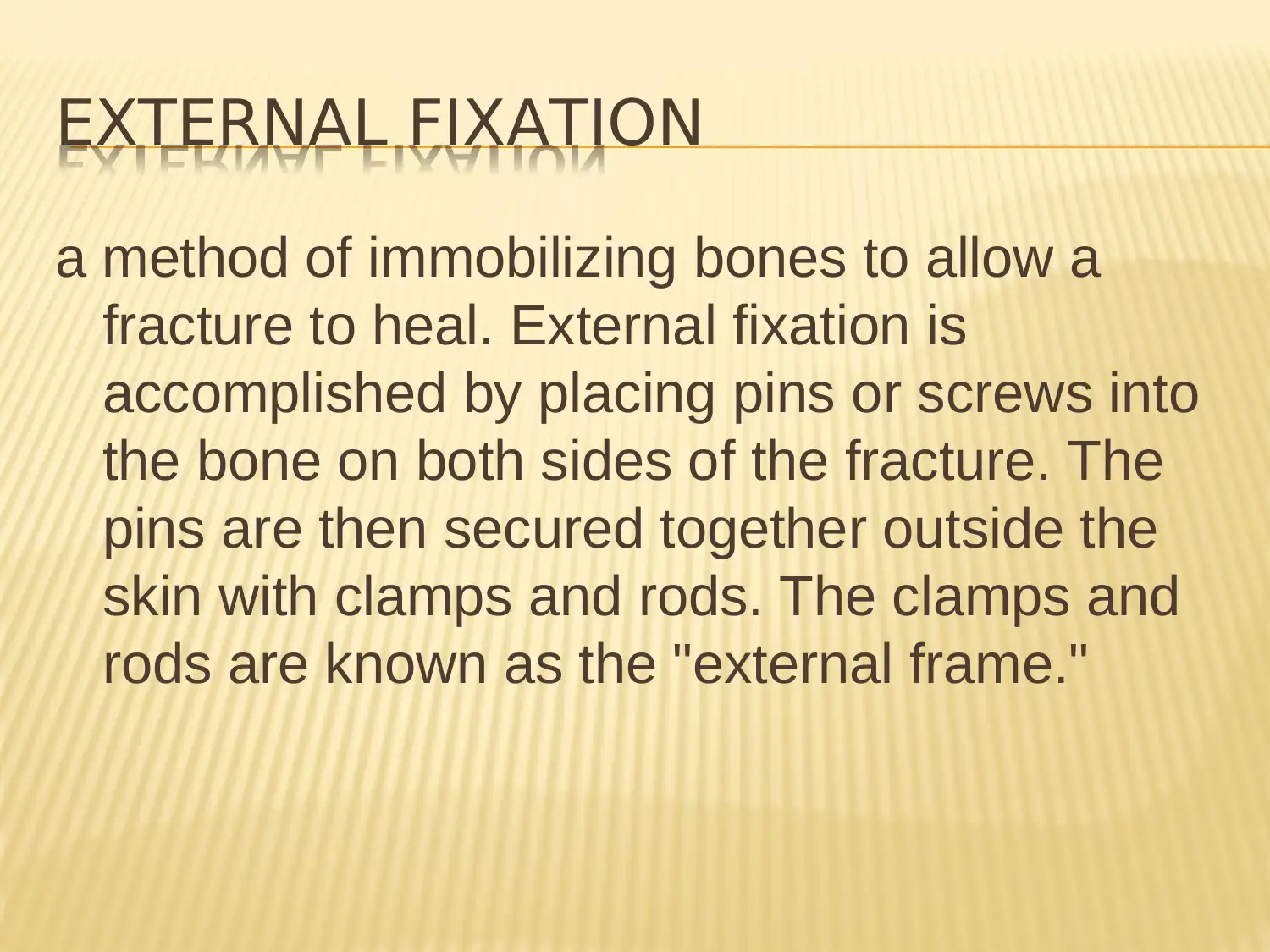
EXTERNAL FIXATION
a method of immobilizing bones to allow a
fracture to heal. External fixation is
accomplished by placing pins or screws into
the bone on both sides of the fracture. The
pins are then secured together outside the
skin with clamps and rods. The clamps and
rods are known as the "external frame."
a method of immobilizing bones to allow a
fracture to heal. External fixation is
accomplished by placing pins or screws into
the bone on both sides of the fracture. The
pins are then secured together outside the
skin with clamps and rods. The clamps and
rods are known as the "external frame."
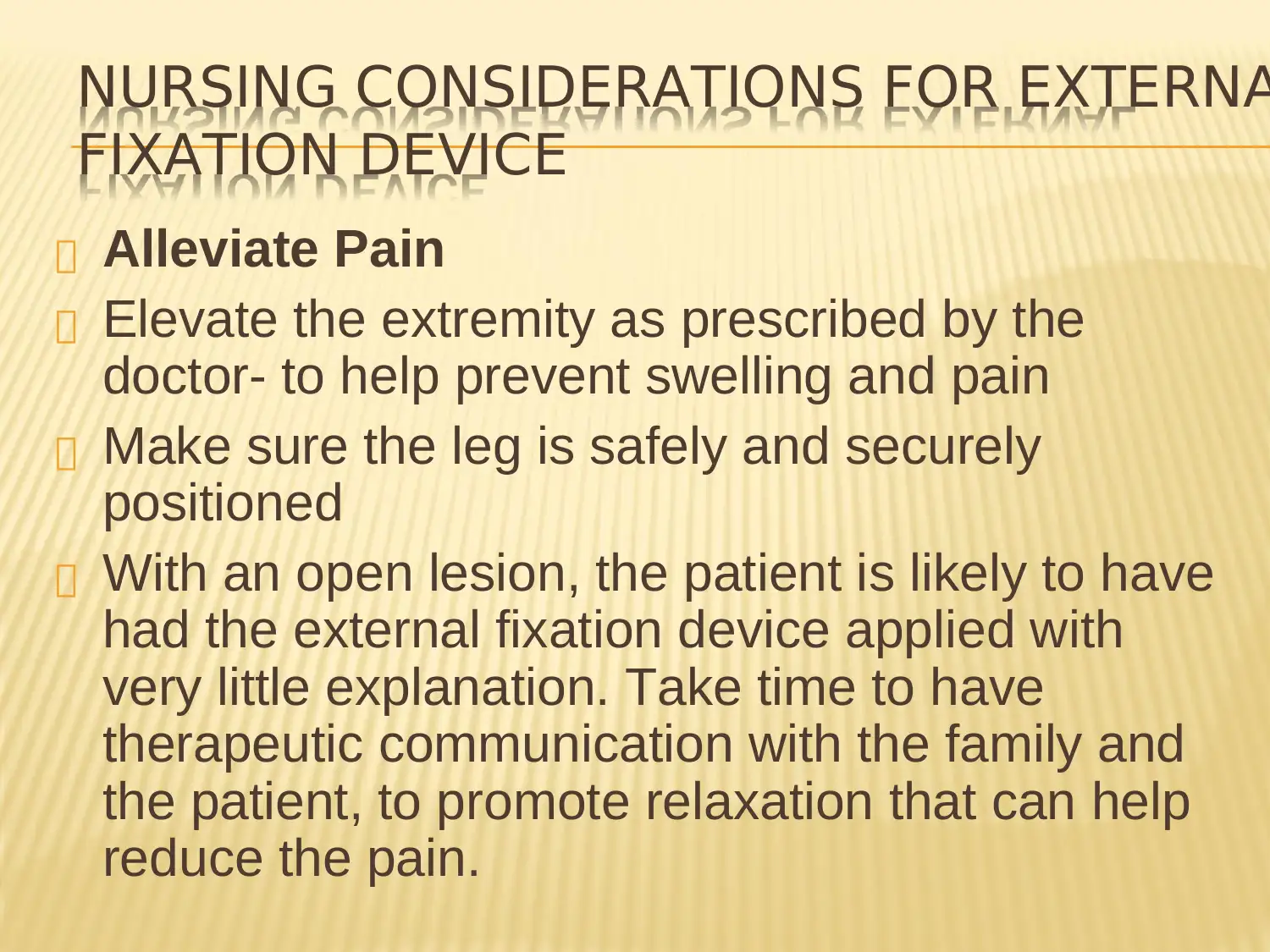
NURSING CONSIDERATIONS FOR EXTERNA
FIXATION DEVICE
Alleviate Pain
Elevate the extremity as prescribed by the
doctor- to help prevent swelling and pain
Make sure the leg is safely and securely
positioned
With an open lesion, the patient is likely to have
had the external fixation device applied with
very little explanation. Take time to have
therapeutic communication with the family and
the patient, to promote relaxation that can help
reduce the pain.
FIXATION DEVICE
Alleviate Pain
Elevate the extremity as prescribed by the
doctor- to help prevent swelling and pain
Make sure the leg is safely and securely
positioned
With an open lesion, the patient is likely to have
had the external fixation device applied with
very little explanation. Take time to have
therapeutic communication with the family and
the patient, to promote relaxation that can help
reduce the pain.
⊘ This is a preview!⊘
Do you want full access?
Subscribe today to unlock all pages.

Trusted by 1+ million students worldwide
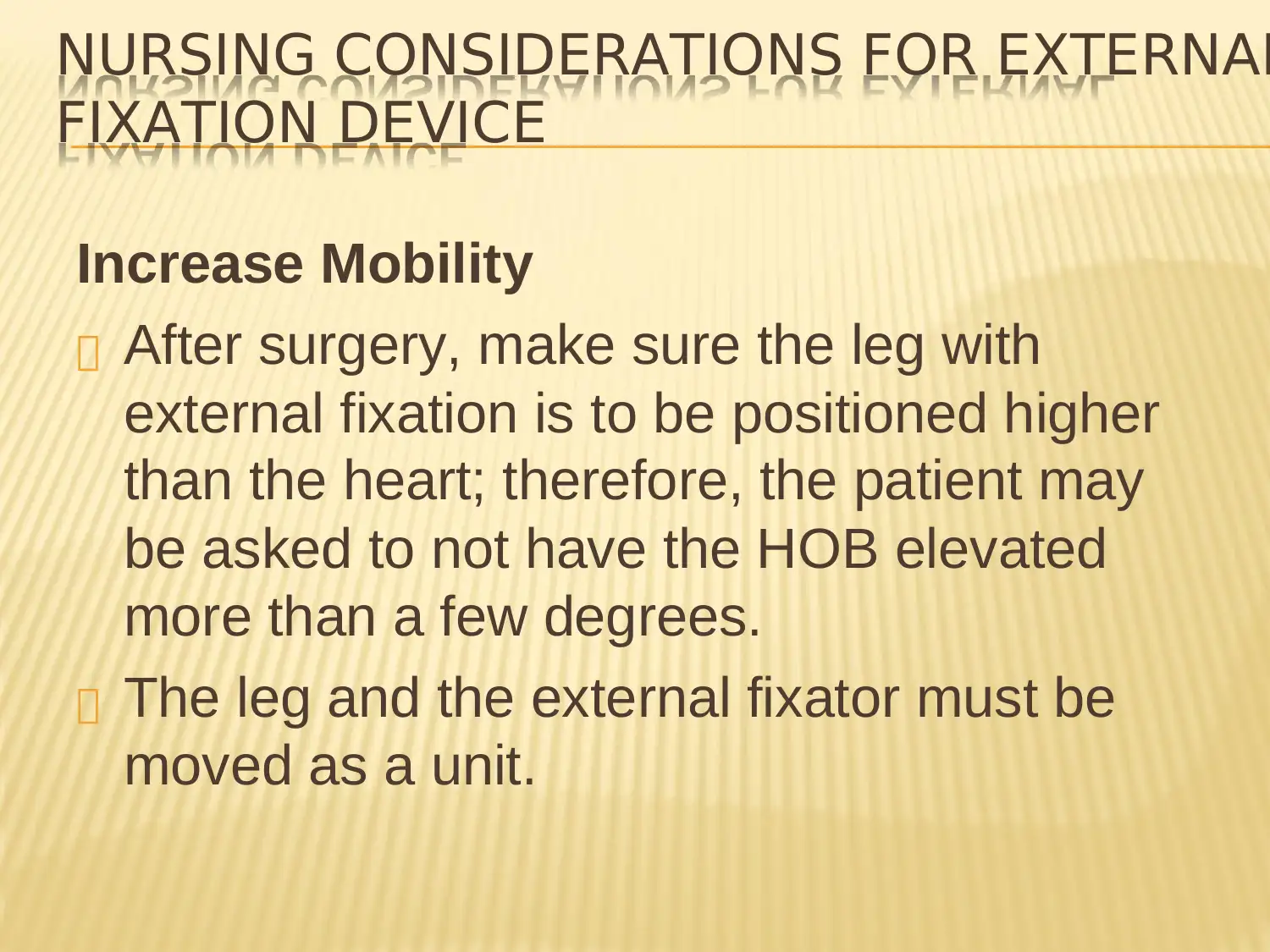
NURSING CONSIDERATIONS FOR EXTERNAL
FIXATION DEVICE
Increase Mobility
After surgery, make sure the leg with
external fixation is to be positioned higher
than the heart; therefore, the patient may
be asked to not have the HOB elevated
more than a few degrees.
The leg and the external fixator must be
moved as a unit.
FIXATION DEVICE
Increase Mobility
After surgery, make sure the leg with
external fixation is to be positioned higher
than the heart; therefore, the patient may
be asked to not have the HOB elevated
more than a few degrees.
The leg and the external fixator must be
moved as a unit.
Paraphrase This Document
Need a fresh take? Get an instant paraphrase of this document with our AI Paraphraser
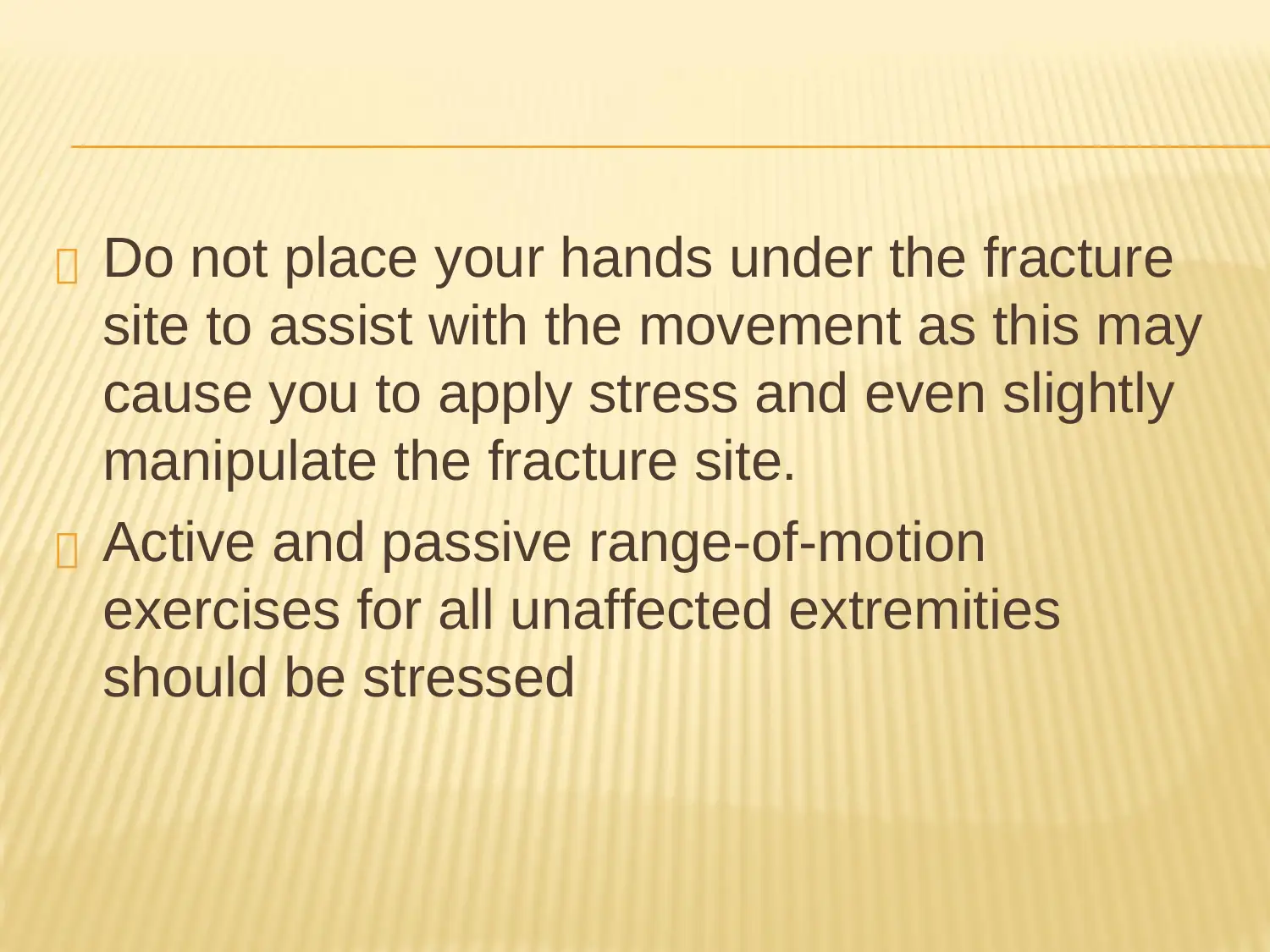
Do not place your hands under the fracture
site to assist with the movement as this may
cause you to apply stress and even slightly
manipulate the fracture site.
Active and passive range-of-motion
exercises for all unaffected extremities
should be stressed
site to assist with the movement as this may
cause you to apply stress and even slightly
manipulate the fracture site.
Active and passive range-of-motion
exercises for all unaffected extremities
should be stressed
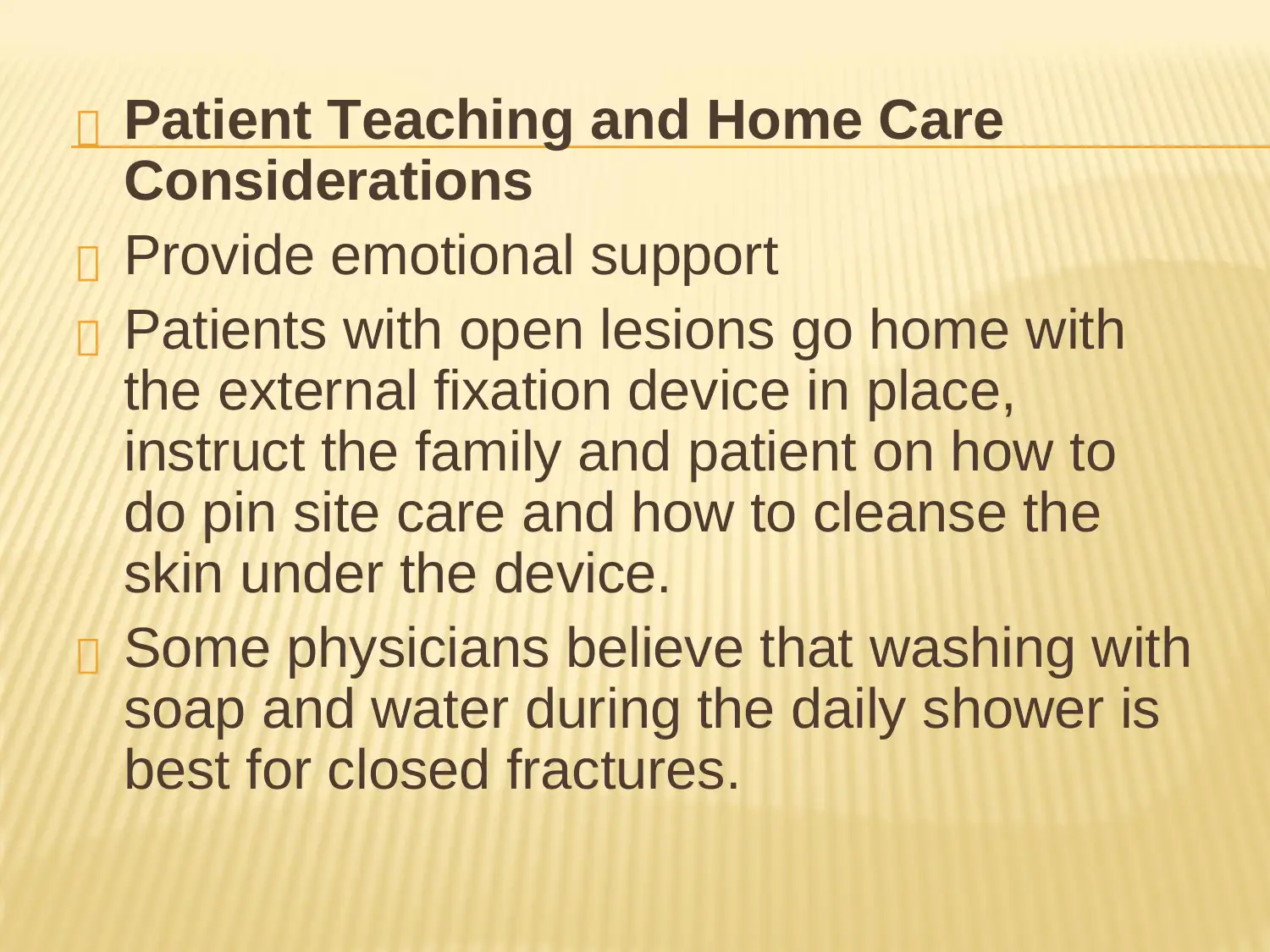
Patient Teaching and Home Care
Considerations
Provide emotional support
Patients with open lesions go home with
the external fixation device in place,
instruct the family and patient on how to
do pin site care and how to cleanse the
skin under the device.
Some physicians believe that washing with
soap and water during the daily shower is
best for closed fractures.
Considerations
Provide emotional support
Patients with open lesions go home with
the external fixation device in place,
instruct the family and patient on how to
do pin site care and how to cleanse the
skin under the device.
Some physicians believe that washing with
soap and water during the daily shower is
best for closed fractures.
⊘ This is a preview!⊘
Do you want full access?
Subscribe today to unlock all pages.

Trusted by 1+ million students worldwide
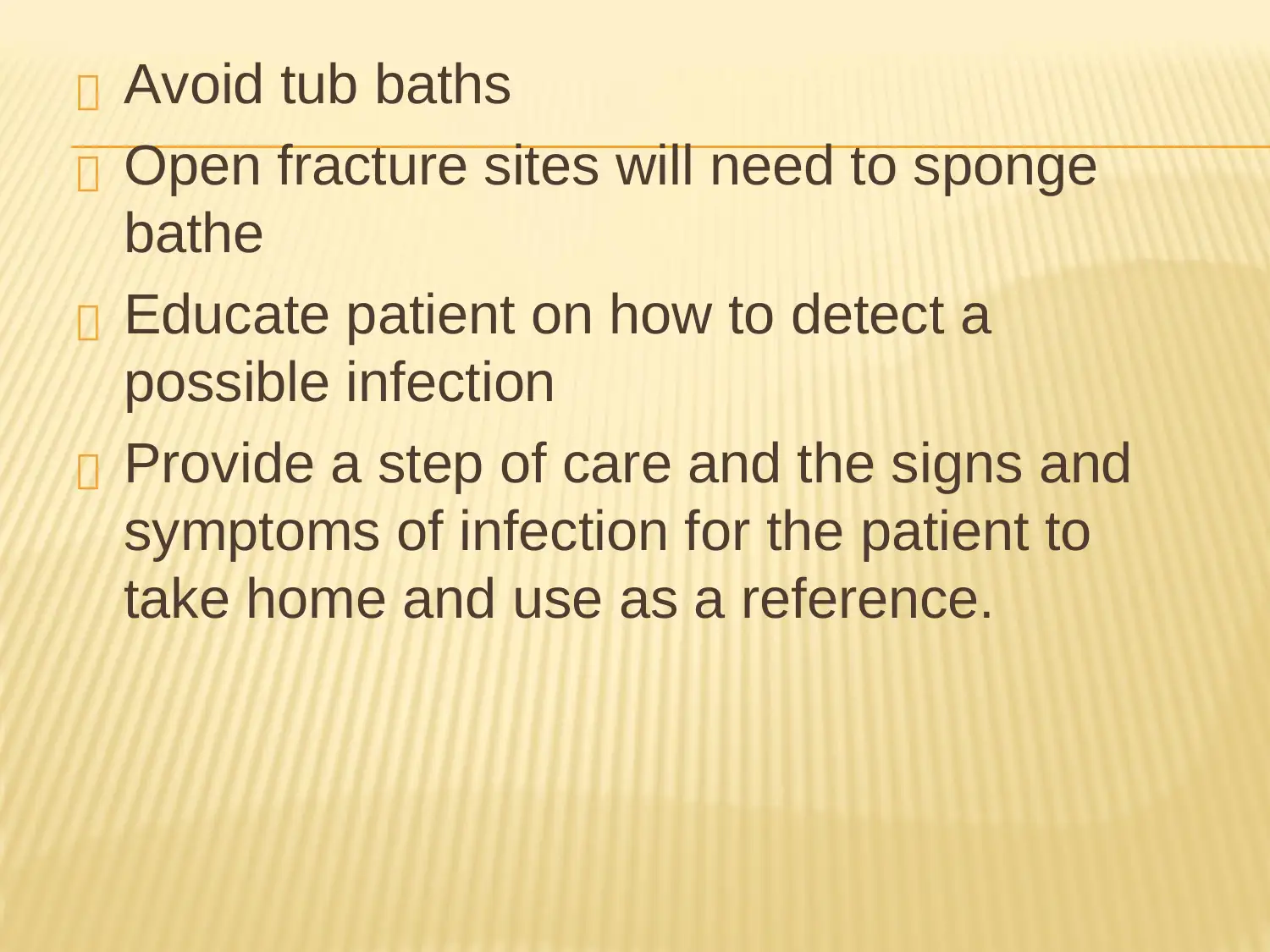
Avoid tub baths
Open fracture sites will need to sponge
bathe
Educate patient on how to detect a
possible infection
Provide a step of care and the signs and
symptoms of infection for the patient to
take home and use as a reference.
Open fracture sites will need to sponge
bathe
Educate patient on how to detect a
possible infection
Provide a step of care and the signs and
symptoms of infection for the patient to
take home and use as a reference.
Paraphrase This Document
Need a fresh take? Get an instant paraphrase of this document with our AI Paraphraser
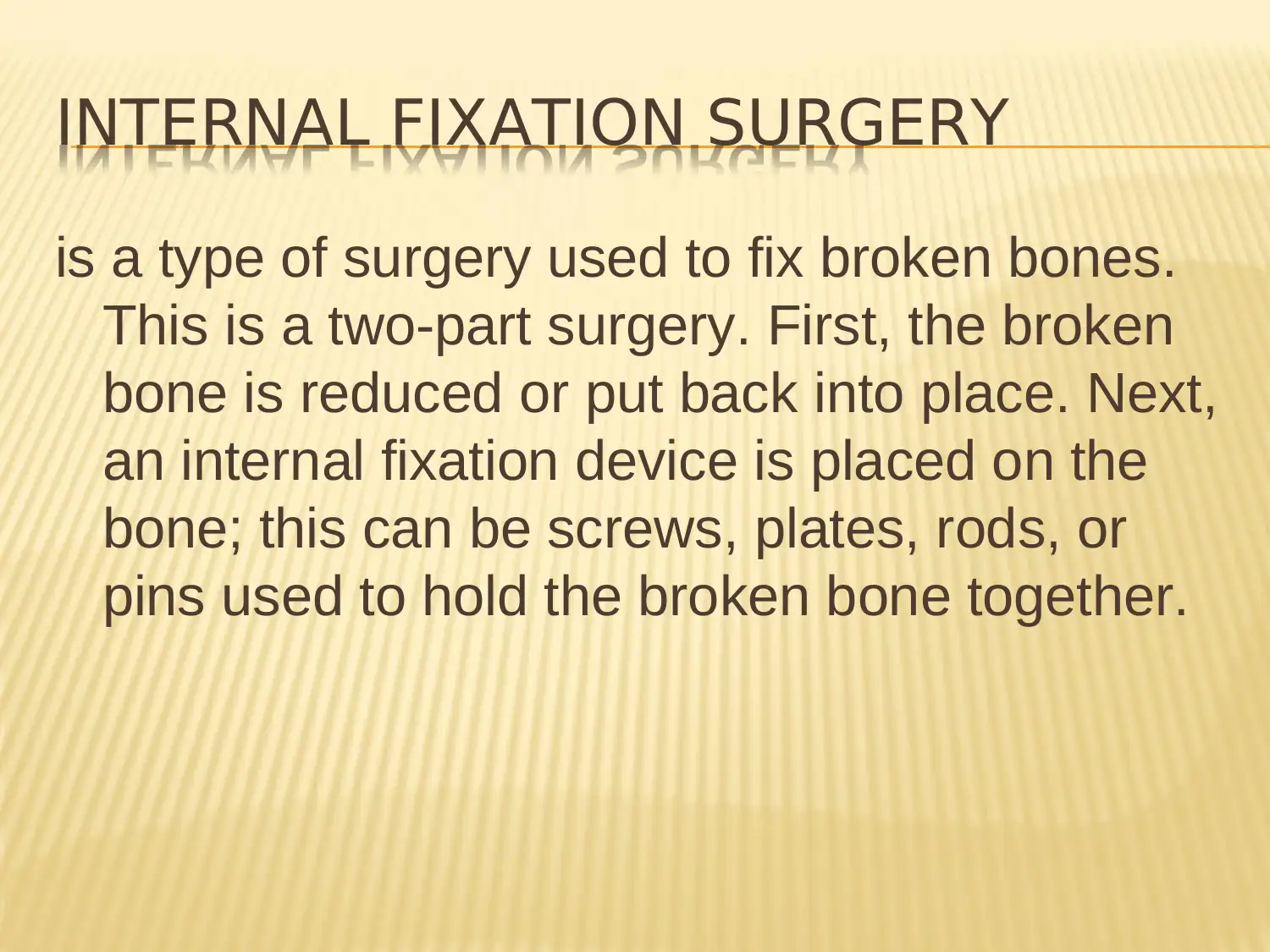
INTERNAL FIXATION SURGERY
is a type of surgery used to fix broken bones.
This is a two-part surgery. First, the broken
bone is reduced or put back into place. Next,
an internal fixation device is placed on the
bone; this can be screws, plates, rods, or
pins used to hold the broken bone together.
is a type of surgery used to fix broken bones.
This is a two-part surgery. First, the broken
bone is reduced or put back into place. Next,
an internal fixation device is placed on the
bone; this can be screws, plates, rods, or
pins used to hold the broken bone together.
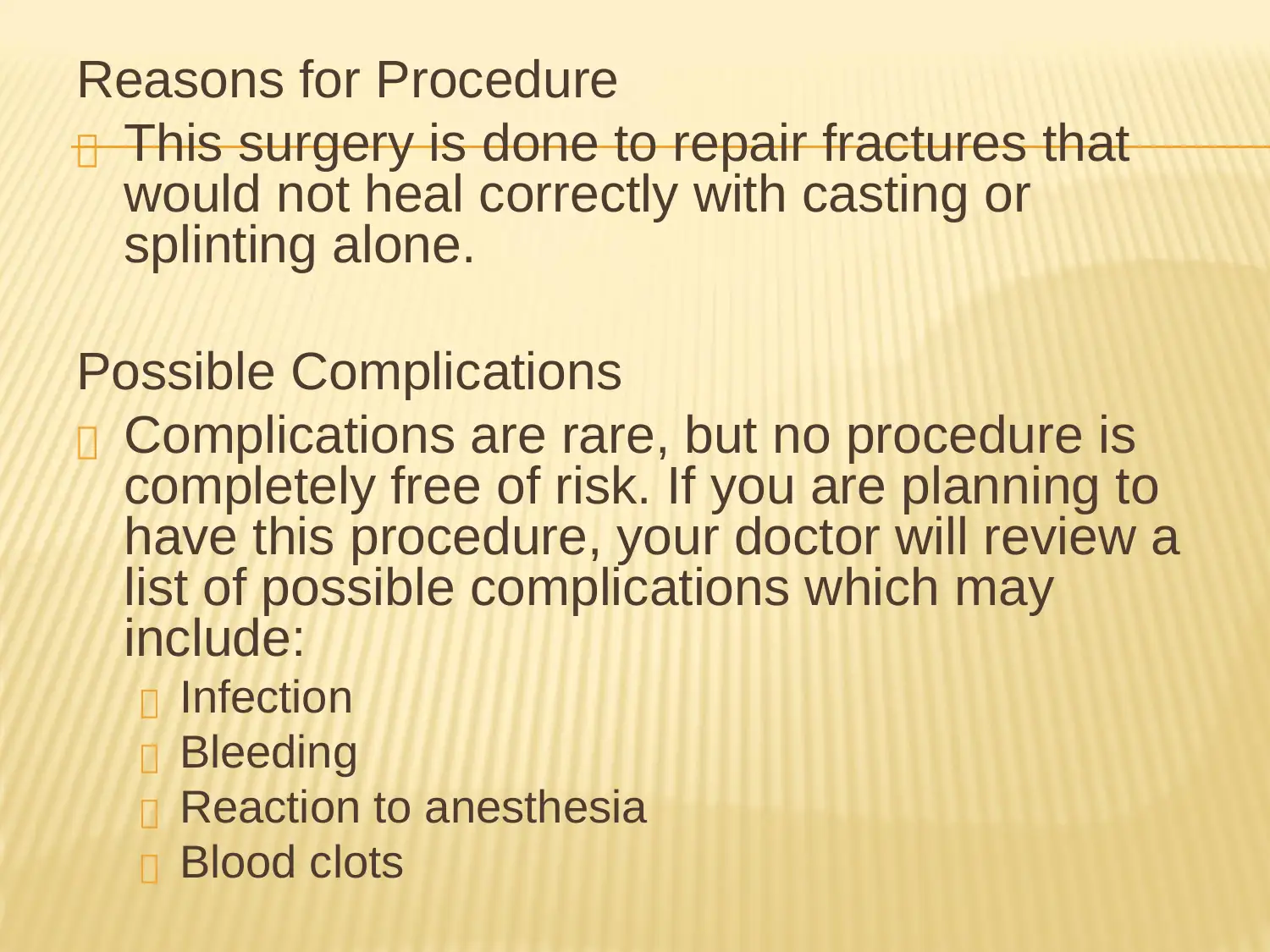
Reasons for Procedure
This surgery is done to repair fractures that
would not heal correctly with casting or
splinting alone.
Possible Complications
Complications are rare, but no procedure is
completely free of risk. If you are planning to
have this procedure, your doctor will review a
list of possible complications which may
include:
Infection
Bleeding
Reaction to anesthesia
Blood clots
This surgery is done to repair fractures that
would not heal correctly with casting or
splinting alone.
Possible Complications
Complications are rare, but no procedure is
completely free of risk. If you are planning to
have this procedure, your doctor will review a
list of possible complications which may
include:
Infection
Bleeding
Reaction to anesthesia
Blood clots
⊘ This is a preview!⊘
Do you want full access?
Subscribe today to unlock all pages.

Trusted by 1+ million students worldwide
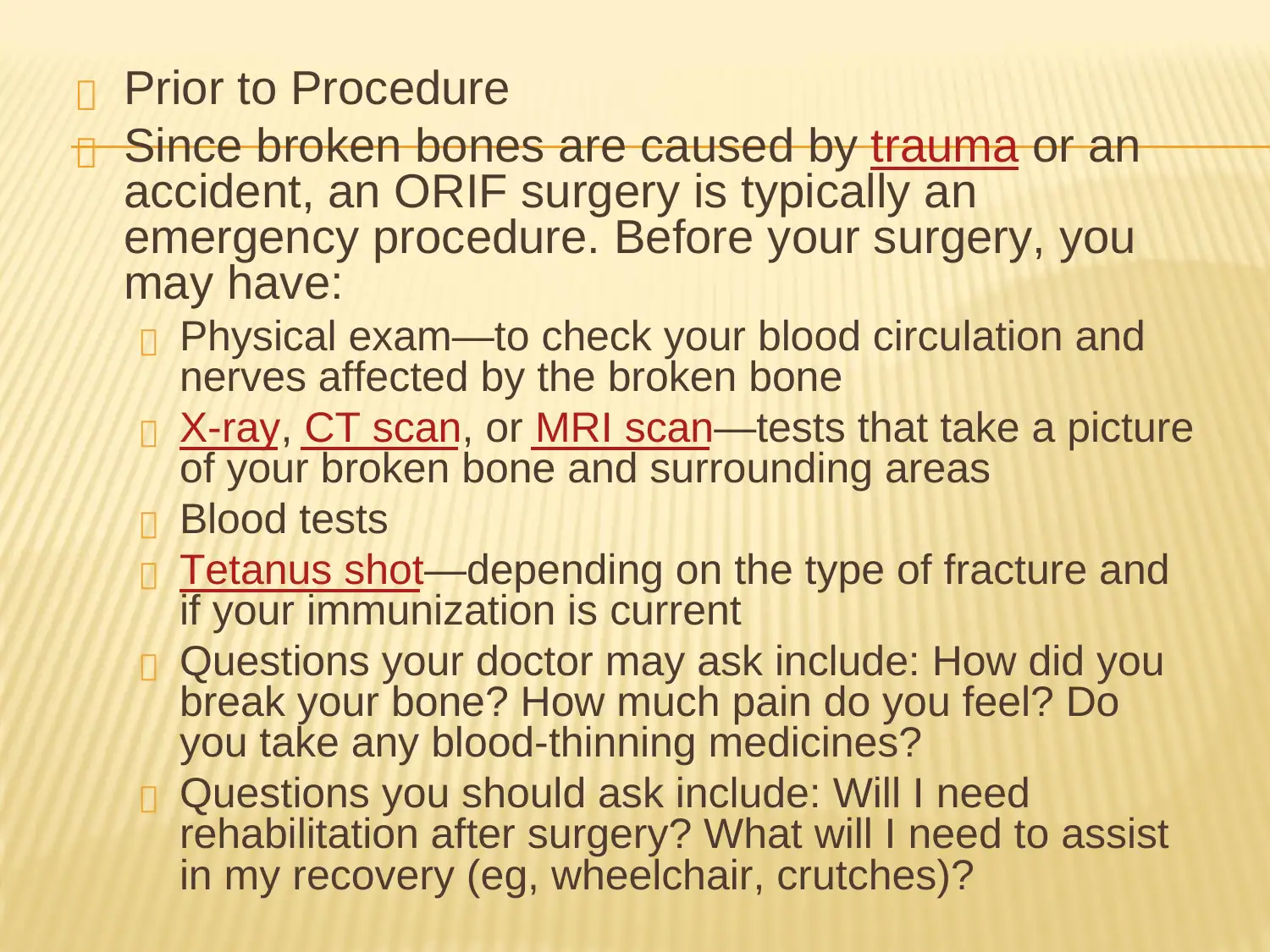
Prior to Procedure
Since broken bones are caused by trauma or an
accident, an ORIF surgery is typically an
emergency procedure. Before your surgery, you
may have:
Physical exam—to check your blood circulation and
nerves affected by the broken bone
X-ray, CT scan, or MRI scan—tests that take a picture
of your broken bone and surrounding areas
Blood tests
Tetanus shot—depending on the type of fracture and
if your immunization is current
Questions your doctor may ask include: How did you
break your bone? How much pain do you feel? Do
you take any blood-thinning medicines?
Questions you should ask include: Will I need
rehabilitation after surgery? What will I need to assist
in my recovery (eg, wheelchair, crutches)?
Since broken bones are caused by trauma or an
accident, an ORIF surgery is typically an
emergency procedure. Before your surgery, you
may have:
Physical exam—to check your blood circulation and
nerves affected by the broken bone
X-ray, CT scan, or MRI scan—tests that take a picture
of your broken bone and surrounding areas
Blood tests
Tetanus shot—depending on the type of fracture and
if your immunization is current
Questions your doctor may ask include: How did you
break your bone? How much pain do you feel? Do
you take any blood-thinning medicines?
Questions you should ask include: Will I need
rehabilitation after surgery? What will I need to assist
in my recovery (eg, wheelchair, crutches)?
Paraphrase This Document
Need a fresh take? Get an instant paraphrase of this document with our AI Paraphraser
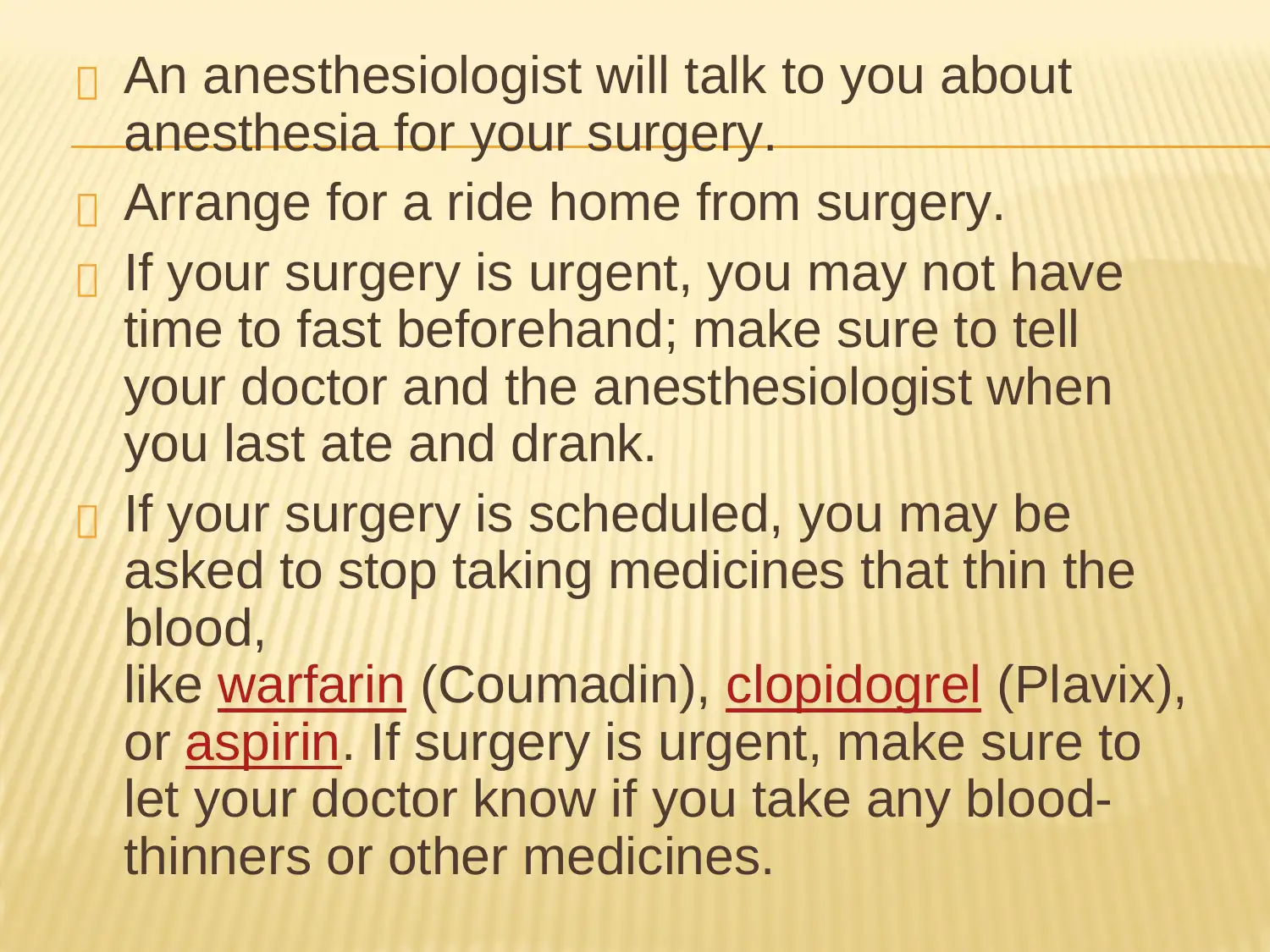
An anesthesiologist will talk to you about
anesthesia for your surgery.
Arrange for a ride home from surgery.
If your surgery is urgent, you may not have
time to fast beforehand; make sure to tell
your doctor and the anesthesiologist when
you last ate and drank.
If your surgery is scheduled, you may be
asked to stop taking medicines that thin the
blood,
like warfarin (Coumadin), clopidogrel (Plavix),
or aspirin. If surgery is urgent, make sure to
let your doctor know if you take any blood-
thinners or other medicines.
anesthesia for your surgery.
Arrange for a ride home from surgery.
If your surgery is urgent, you may not have
time to fast beforehand; make sure to tell
your doctor and the anesthesiologist when
you last ate and drank.
If your surgery is scheduled, you may be
asked to stop taking medicines that thin the
blood,
like warfarin (Coumadin), clopidogrel (Plavix),
or aspirin. If surgery is urgent, make sure to
let your doctor know if you take any blood-
thinners or other medicines.
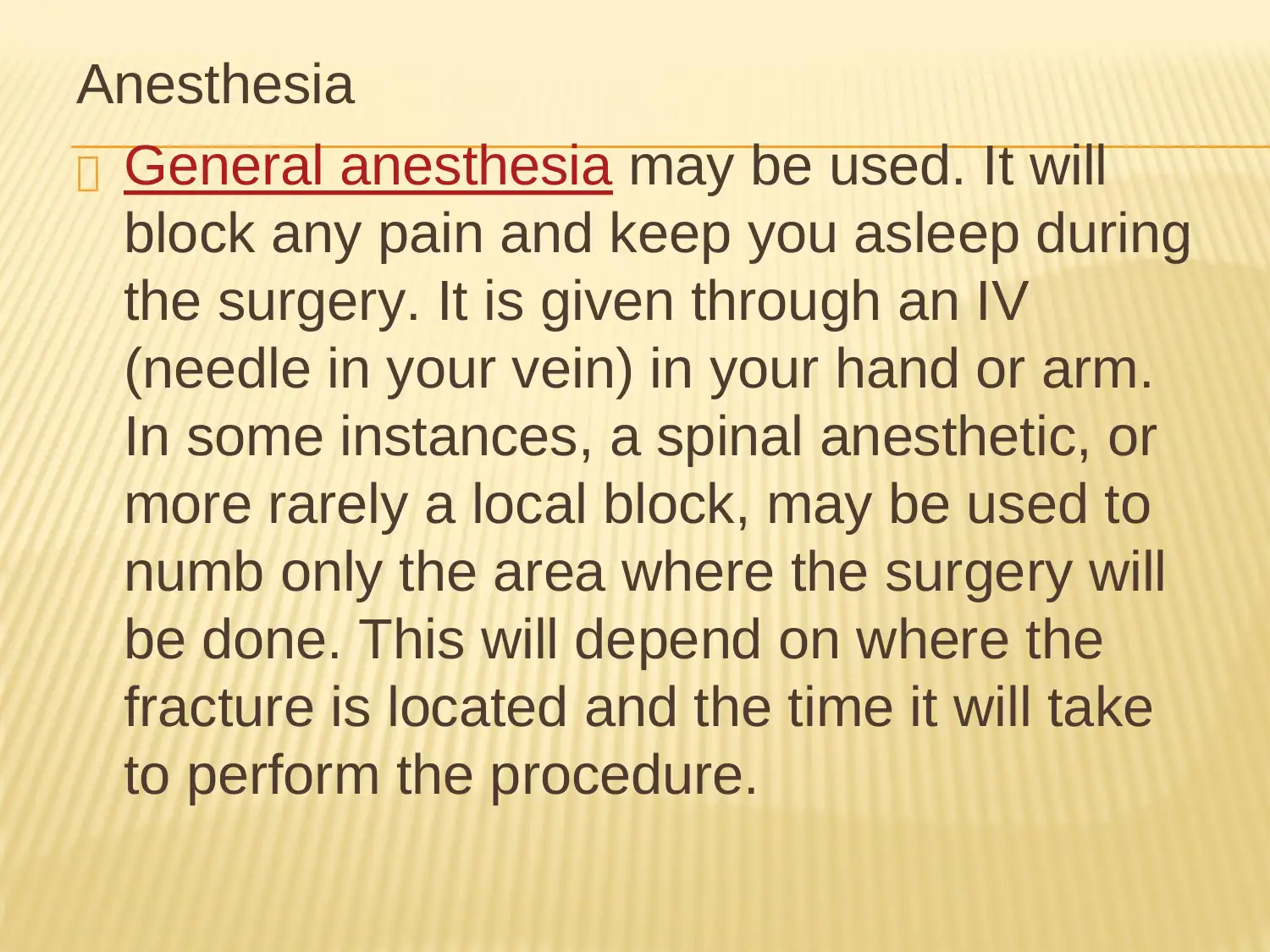
Anesthesia
General anesthesia may be used. It will
block any pain and keep you asleep during
the surgery. It is given through an IV
(needle in your vein) in your hand or arm.
In some instances, a spinal anesthetic, or
more rarely a local block, may be used to
numb only the area where the surgery will
be done. This will depend on where the
fracture is located and the time it will take
to perform the procedure.
General anesthesia may be used. It will
block any pain and keep you asleep during
the surgery. It is given through an IV
(needle in your vein) in your hand or arm.
In some instances, a spinal anesthetic, or
more rarely a local block, may be used to
numb only the area where the surgery will
be done. This will depend on where the
fracture is located and the time it will take
to perform the procedure.
⊘ This is a preview!⊘
Do you want full access?
Subscribe today to unlock all pages.

Trusted by 1+ million students worldwide
1 out of 24
Related Documents
Your All-in-One AI-Powered Toolkit for Academic Success.
+13062052269
info@desklib.com
Available 24*7 on WhatsApp / Email
![[object Object]](/_next/static/media/star-bottom.7253800d.svg)
Unlock your academic potential
Copyright © 2020–2025 A2Z Services. All Rights Reserved. Developed and managed by ZUCOL.




